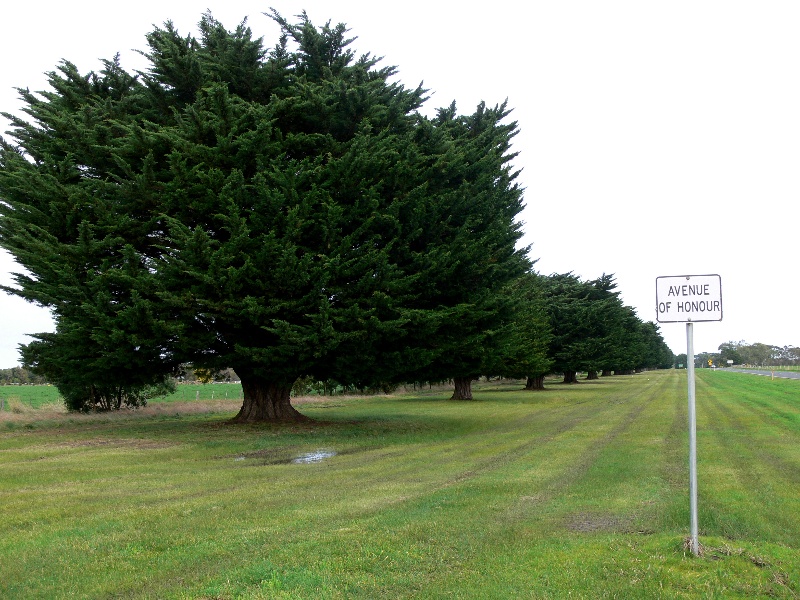Ellerslie Avenue of Honour
Hopkins Highway, Ellerslie VIC 3265
-
Add to tour
You must log in to do that.
-
Share
-
Shortlist place
You must log in to do that.
- Download report


Statement of Significance
The Avenue of Honour on the Hopkins Highway at Ellerslie comprises a row of mature Monterey Cypress (Cupressus macrocarpa). It was planted in the 1920s, in the wake of the First World War.
How is it significant?
The Avenue of Honour on the Hopkins Highway at Ellerslie is of historical, scientific (horticultural), social and aesthetic significance to the Shire of Moyne.
Why is it significant?
The Avenue of Honour on the Hopkins Highway at Ellerslie is of local historical significance as a collection of trees planted to commemorate local service personnel who served overseas in World War I. It is representative of plantings that first appeared in Australia during World War I, and commemorated all those who enlisted for service in an egalitarian form where each individual was equally recognised for their service regardless of rank. [from 'Eurack Avenue of Honour', citation, Heritage Victoria]
The Avenue of Honour on the Hopkins Highway at Ellerslie is of local historical significance as an impressive, intact and integral part of the Victorian network of Avenues of Honour, planted to memorialise those who fought in wars overseas, and at one time totalling some 128 throughout Victoria, and now much reduced.
The Avenue of Honour on the Hopkins Highway at Ellerslie is of local social significance for its relationship to the community as a memorial to those who served in the First World War, and for its continuing commemorative importance. It remains as an indication of the involvement of Victoria's small communities in commemorating the sacrifices of their volunteers, and the loss and sorrow experienced by small rural areas across Victoria. [from 'Eurack Avenue of Honour', citation, Heritage Victoria] This significance is enhanced by its association with the Ellerslie war memorial.
The Avenue of Honour on the Hopkins Highway at Ellerslie is of local scientific (horticultural) value as a collection of mature Monterey Cypresses (Cupressus macrocarpa) of an approximately known age.
The Avenue of Honour on the Hopkins Highway at Ellerslie is of local aesthetic significance for the imposing streetscape formed by its uniform cypress planting and for forming attractive row of mature trees through the main street in the town.
-
-
Ellerslie Avenue of Honour - Physical Description 1
A row of mature Monterey Cypress (Cupressus macrocarpa) planted in the road reserve on the east side of the Hopkins Highway at Ellerslie.
COMPARATIVE ANALYSIS
The single row of Monterey Cypress at Ellerslie is one of an important collection of avenues (and rows) of honour planted in Moyne Shire after World War I. Monterey Cypress was the most common species used for these plantings. The avenue of honour at Mortlake is the most impressive with around 200 trees. Other examples of Cypress that are comparable with the Ellerslie planting include that at Orford and Woorndoo. The trees at Ellerslie were planted as a single row rather than as an avenue proper, which makes it similar to Grassmere and Narringal.Ellerslie Avenue of Honour - Physical Conditions
Good
Ellerslie Avenue of Honour - Integrity
Intact
Veterans Description for Public
Ellerslie Avenue of Honour - Veterans Description for Public
The single row of Monterey Cypress, along Hopkins Highway at Ellerslie, is one of an important collection of avenues of honour planted in Moyne Shire after the First World War. Monterey Cypress (Cupressus macrocarpa) was the most common species used for these plantings. Thirty trees were originally planted in 1920, one for each man who enlisted, eleven of whom were killed. Twenty-nine trees still remain although the name plaques are now mostly gone.
Other examples of Cypress avenues that are comparable with the Ellerslie planting, include Orford and Woorndoo. The trees at Ellerslie were planted as a single row rather than as an avenue proper, which makes it similar to Grassmere and Narringal.
In Australia, commemorative trees have been planted in public spaces since the late nineteenth century. Arbor Days were held regularly in most Victorian State Schools during the late 1800s and early 1900s, and numerous trees were planted in parks in Melbourne and throughout Victoria to mark the visits of important and famous people.
This tradition of commemorative planting was continued in 1901 when at the end of the Boer War trees were often planted for each soldier of the district who was killed in South Africa. These plantings, however, rarely consisted of more than two or three trees in each town.
During and after the First World War avenues of honour consisting of trees lining significant streets became a popular form of commemoration. They represented a new egalitarian approach to the commemoration of soldiers where rank was not a consideration: each tree symbolises a person.
Avenues of honour are a uniquely Australian phenomenon. Australians, and in particular Victorians, embraced the idea of planting them more enthusiastically than any other country in the world. The Eurack Avenue of Honour is the earliest known avenue of honour to be planted in Victoria and dates from May 1916.
By the time of the Second World War avenues of honour had declined in popularity as a means of commemoration. Today it is estimated that over 300 avenues of honour have been planted in Victoria to commemorate service personnel since 1901.
Heritage Study and Grading
Moyne - Moyne Shire Heritage Study Stage 2
Author: Helen Doyle in association with Context P/L
Year: 2006
Grading: Local
-
-
-
-
-
Ellerslie War Memorial
 Vic. War Heritage Inventory
Vic. War Heritage Inventory -
Ellerslie Avenue of Honour
 Vic. War Heritage Inventory
Vic. War Heritage Inventory
-
10 Down Street
 Yarra City
Yarra City
-
-











